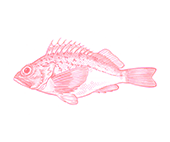




- Better Choice
Wild Caught
Region:
WA
- King George whiting are caught in VIC, SA and WA. Stocks are mainly considered healthy.
- King George whiting are caught using haul/beach seine, demersal gillnets and line fishing methods in small scale commercial fisheries along WA’s west and south coast.
- King George whiting grows and reproduces quickly and so is relatively resilient to fishing pressure. WA populations are relatively poorly understood, but are likely in healthy condition.
- King George whiting grows and reproduces quickly and so is relatively resilient to fishing pressure.
- Line, bottom gillnet and haul net fishing methods used to catch king george whiting generally have low impacts on marine habitats and threatened species.






King George Whiting is the most highly-regarded of all the Whitings, prized for its firm, clean, sweet-tasting white flesh and its delicate flake. Very fresh specimens can be thinly sliced or diced and eaten raw as sashimi or in a ceviche. They are great to pan fry or BBQ whole or as fillets. Whiting can become dry if overcooked, so a coating such as a crumb or batter is often used to protect the flesh from direct heat. Try pan frying or deep-frying after coating. Whole fish can be baked in the oven with a little oil, lemon and salt. Whiting’s delicate flesh also suits it to steaming, which will help keep it juicy and moist.
- WA South Coast Estuarine Managed Fishery, West Coast Estuarine Managed Fishery (14t in 2020/21)
King George Whiting are found throughout southern Australian waters. The juveniles are found in shallow southern waters and migrate to deeper waters when they reach adulthood. The species predate on worms, molluscs and crustaceans. King George whiting are caught mainly in SA and VIC, with very small catches in WA.
King George whiting are caught in a range of small scale estuarine and coastal fisheries across the lower west coast and south coast of WA.
A recent (and the first) basic scientific stock assessment provides evidence that WA king George whiting populations are in very healthy condition, and that there is no risk of overfishing at recent catch levels.
While management of WA king George whiting fishery impacts on other bycatch species, threatened and endangered wildlife, and vulnerable habitats is highly rudimentary, the small scale nature of the fisheries reduces the real risk they pose. These types of fishing methods generally have low impacts on marine habitat and threatened species, although increased reporting by independent fisheries observers would provide additional confidence in reporting of endangered species interactions.
There is relatively little marine park protection across the fishery, though some estuaries are closed to commercial fishing and the future implementation of currently planned marine parks along the south coast’s coastal waters has the potential to significantly advance the scientific management and sustainability of the fishery.


